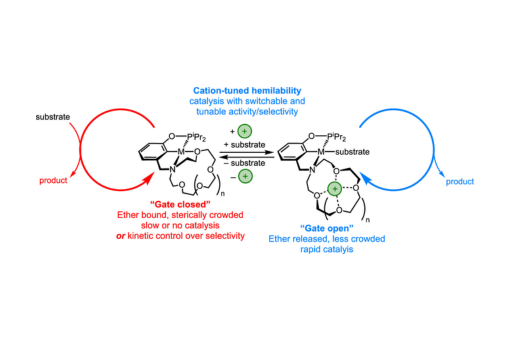Tunable and Switchable Catalysis Enabled by Cation-Controlled Gating with Crown Ether Ligands
Abstract
Catalysis has become an essential tool in science and technology, impacting the discovery of pharmaceuticals, the manufacture of commodity chemicals and plastics, the production of fuels, and much more. In most cases, a particular catalyst is optimized to mediate a particular reaction, continually producing a desired product at a given rate. There is enormous opportunity in developing catalysts that are dynamic, capable of responding to a change in the environment to alter structure and function. Controlled catalysis, in which the activity or selectivity of a catalytic reaction can be adjusted through an external stimulus, offers opportunities for innovation in catalysis. Catalyst discovery could be simplified if a single thoughtfully designed complex could work synergistically with additives to optimize performance rather than trying a multitude of different metal/ligand combinations. Temporal control could be gained to facilitate the execution of multiple reactions in the same flask, for example, by activating one catalyst and deactivating another to avoid incompatibilities. Selectivity switching could enable copolymer synthesis with well-defined chemical and material properties. These applications might sound futuristic for synthetic catalysts, but in nature, such a degree of controlled catalysis is commonplace. For example, allosteric interactions and/or feedback loops modulate enzymatic activity to enable complex small-molecule synthesis and sequence-defined polymerization reactions in complex mixtures containing many catalytic sites. In many cases, regulation is achieved by “gating” substrate access to the active site. Fundamental advances in catalyst design are needed to better understand the factors that enable controlled catalysis in the arena of synthetic chemistry, particularly in achieving substrate gating outside of macromolecular environments. In this Account, the development of design principles for achieving cation-controlled catalysis is described. The guiding hypothesis was that gating substrate access to a catalyst site could be achieved by controlling the dynamics of a hemilabile ligand through secondary Lewis acid/base and/or cation–dipole interactions. To enforce such interactions, catalysts sitting at the interface of organometallic catalysis and supramolecular chemistry were designed. A macrocyclic crown ether was incorporated into a robust organometallic pincer ligand, and these “pincer-crown ether” ligands have been explored in catalysis. Complementary studies of controlled catalysis and detailed mechanistic analysis guided the development of iridium, nickel, and palladium pincer-crown ether catalysts capable of substrate gating. Toggling the gate between open and closed states leads to switchable catalysis, where cation addition/removal changes the turnover frequency or the product selectivity. Varying the degree of gating leads to tunable catalysis, where the activity can be tuned based on the identity and amount of salt added. Research has focused on reactions of alkenes, particularly isomerization reactions, which has in turn led to design principles for cation-controlled catalysts.
Citation
Tunable and Switchable Catalysis Enabled by Cation-Controlled Gating with Crown Ether Ligands
Sebastian Acosta-Calle and Alexander J. M. Miller
Accounts of Chemical Research 2023 56 (8), 971-981
DOI: 10.1021/acs.accounts.3c00056


